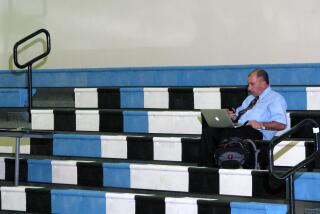Enormously Enjoyable
- Share via
One memory from decades in the blimp especially stands out:
John Crayton was hovering over Candlestick Park in 1989 to broadcast a World Series game between the San Francisco Giants and the Oakland A’s, when the on-board television monitor went blank. He couldn’t see why that should have happened, except for a cloud of dust coming off the hill next to the stadium.
A call to the airport finally made it clear: A major earthquake had struck the Bay Area.
Crayton’s assignment for the night quickly changed. With the airport closed and few flying machines already aloft, the Goodyear blimp and the on-board cameraman became the eyes and ears for the world that evening documenting the 7.1-magnitude Loma Prieta quake.
Crayton is one of five pilots assigned to the Southern California Goodyear blimp, called the Eagle, a regular sight by the side of the San Diego Freeway in Carson. It is one of three blimps owned by the Goodyear Tire & Rubber Co. The other two are in Pompano Beach, Fla. (Stars & Stripes) and Akron, Ohio (Spirit of Akron).
The Eagle’s pilots have a plum job, and they realize it; the least experienced among them has racked up 16 years. They see dozens of football and baseball games every year. They hover over the Rose Bowl, the Super Bowl and the World Series when those events are in the West. They meet scores of famous people and just plain folks. The five pilots travel the length of the western United States on promotional tours from San Diego to Vancouver, Canada.
But the blimp they fly is barely a year old. Last year, a strong gust badly damaged the 192-foot-long blimp on the afternoon of May 27 as it was hovering over the landing pad. While one engine was running, a quick-shifting wind tossed the sausage-shaped aircraft into and then over a wire fence and onto the adjoining Victoria Golf Course. Pilot Joel Chamberlain was in the blimp gondola with five passengers who got a rougher ride than they expected. But no one was hurt, said Goodyear spokesman Bob Urhausen.
The accident ripped a large hole in the tail area. The deflated blimp was a puddle of polyester.
Rather than repair it, Goodyear decided to put together a new blimp in Akron, where the company is headquarters. The new craft arrived in Southern California in October and still flies 45-minute promotional tours every day for Goodyear clients carried aloft inside the six-passenger gondola. The blimp makes about 10 trips a day over Southern California, but tours are not available to the public. And three times a week the airship flies in the evening, flashing public service announcements on its 105-foot-long lighted sign.
Chief Pilot Nick Nicolary has flown the blimp 28 years, since he answered a classified ad that said: “Wanted. Blimp pilots.” A colleague at Douglas Aircraft in Long Beach cut it out and handed it to Nicolary, who was writing maintenance and flight manuals at the time but had a commercial pilot’s license.
*
One day, Nicolary ferried around one of his childhood heroes--Air Force test pilot Chuck Yeager, who broke the sound barrier in 1947. Yeager had lots of questions about the slow-moving blimp, which cruises at a modest 35 mph. Nicolary had a lot of questions about traveling faster than the speed of sound.
Crayton remembers the time 10 years ago he was flying the airship from San Diego back to Carson. The head winds were so strong that he was traveling only 5 mph. A Los Angeles Police Department helicopter flying nearby radioed to see if he needed help.
“I asked them to fly around and figure out where the wind wasn’t as strong,” the pilot recalled. “They radioed back that if I could get down as low as 600 feet (the blimp’s normal flying altitude is between 1,000 and 3,000 feet), the wind was strong but not as strong. . . . As I crossed the 405 Freeway at about 9 p.m. that evening, I noticed there was no traffic on the freeway in either direction, which I thought was odd for a Sunday.”
After landing safely, he found out the California Highway Patrol had seen the low-flying blimp, feared the worst and closed traffic in both directions.
Slow speeds and high winds are the main drawbacks to his job, but Crayton wouldn’t it for any other.
“I’m a very lucky person,” he shouted over the constant drone of the engines while the blimp floated above the blue-gray Pacific Ocean. “I have an office with a view that changes all the time.”
More to Read
Sign up for The Wild
We’ll help you find the best places to hike, bike and run, as well as the perfect silent spots for meditation and yoga.
You may occasionally receive promotional content from the Los Angeles Times.






